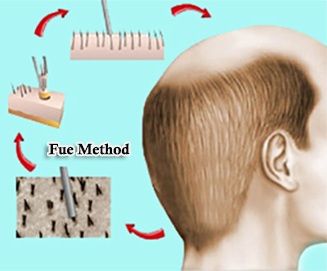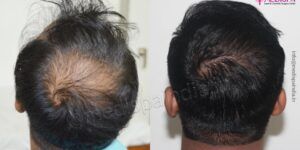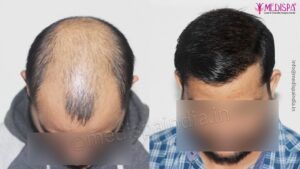What is FUE?
FUE (follicular unit extraction) is a type of hair transplant surgery in which hair follicles are extracted from the donor parts of the head, usually sides and back of the head using a FUE punch, and are transplanted to areas of baldness on the scalp. Donor area can be defined as site on the scalp from where hair follicles are taken during a hair transplant procedure. Each hair follicle, consisting of 1-4 hairs, is extracted under local anaesthesia. The transplanted hairs continue to grow if the surgery is performed by a skilled surgeon.

FUE hair transplant
How FUE is done?
For the extraction of the hair follicles, a micro surgical instrument, FUE punch measuring 0.6 mm to 1 mm in diameter is used. Then, these hair grafts are transplanted to the recipient area with baldness in to a micro incision using surgical needles. The hair grafts are implanted at a specific angle and in proper density approximating that of natural hairs. Usually, FUT is treatment of choice for patients with higher Norwood scale patients, however, FUE hair transplant is favourable for those patients willing to wear short hairs in whom a linear scar at the donor site would be visible. However, there are some unique challenges experienced by the surgeon performing FUE. The shortcoming of the FUE procedure is that it requires sensitive and consistent approach for extraction of the hair follicles, from first one to the last follicle. Most of the hair surgeons consider a limit of extracting around 1,500 to 2000 grafts per session.
What is overharvesting of donor site in FUE?
Overharvesting of the donor site is one of the commonly seen issues with large volume hair transplant cases. The overharvesting can result in aesthetically unpleasant conditions such as patches of bald spots at the donor areas and “moth eaten look” of the donor site. Moreover, the viability of the extracted hair grafts is also compromised because the grafts are potentially kept outside the body for longer durations.
Availability of hair follicles at donor sites
Normally, the donor area has 80-120 follicular units per square cm, thus, a normal person has approximately 20,000-25,000 hair follicle units in the occipital region. Nevertheless, we cannot extract all the follicular units as the patient would be hairless in that region. Generally, it is proposed to extract 15-20% of the grafts in an area with minimal baldness or thin hairs. A surgeon should extract about 20 follicles per sq. cm with a 1mm FUE punch, and about 25 follicles per sq. cm with a 0.75 mm punch. A cautious measurement should be done prior to the surgery.
Why is overharvesting common?
The FUE donor count is more for treatment of higher Norwood scale patients. Few doctors extract high number of grafts, such as 4000 or 5000 at a single FUE session, in an attempt to increase the number of extracted grafts, can lead up to damaged donor sites. Miniaturization need to be taken into consideration when measuring the starting donor hair density, it must also be taken into consideration when managing an extraction pattern so as not to create excessive trauma to the donor area due to the harvesting extraction points being close together, either by reducing or limiting the size of the donor area or by attempting to reach high graft numbers.
How to avoid overharvesting
Choose hair transplant clinic wisely
The clinics advertising one day procedure for 4000-5000 grafts should be avoided. The extraction of enormous number of grafts in a small duration of time can lead up to over harvesting, damage to the donor area, and reduced possibility for correctional procedures.
Controlled hair grafts extraction
Non-skilled surgeons who attempts extraction of more than 4000 grafts per day should be avoided. It has been seen that surgeons let the task of punching to the non-skilled technicians. Moreover, in some cases, surgeons need to punch 6000 grafts to end up with 4000 non-transected grafts which can lead to high wastage of donor area and high depletion of the donor site.
Opting for skilled surgeon
Expertise in surgical skills and artistic approach are pivotal for avoiding depletion of the grafts at donor site.
Planning multiple sessions for higher number of grafts
Multiple sessions for hair grafts can be planned in patients who need huge number of hair grafts to cover their hair loss regions. For example, if a patient needs 6000 grafts for covering the baldness, it should be done over 2-3 sessions with at least 6 months interval. Multiple sessions for harvesting of grafts are also scheduled to avoid fatigue in the surgeon and technician, which can lead to low harvest quality.
Treatment of Overharvested donor areas:
Scalp Micropigmentation
Scalp Micropigmentation (SMP) is a highly advanced method of cosmetic pigmentation. SMP involves the use of highly specialized equipment and techniques to inject pigment into the scalp.




